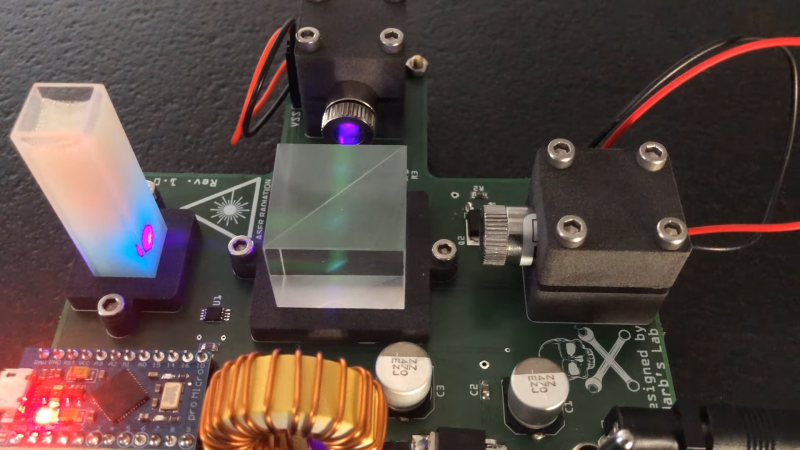One of the first logic circuits most of us learn about is the humble flip-flop. They’re easy enough to build with just a couple of NOR or NAND gates, and even building one up from discrete components isn’t too much of a chore. But building a flip-flop from chemicals and lasers is another thing entirely.
That’s the path [Markus Bindhammer] took for his photochromic molecular switch. We suspect this is less of an attempt at a practical optical logic component and more of a demonstration project, but either way, it’s pretty cool. Photochromism is the property by which molecules reversibly rearrange themselves and change color upon exposure to light, the most common example being glass that darkens automatically in the sun. This principle can be used to create an optical flip-flop, which [Markus] refers to as an “RS” type but we’re pretty sure he means “SR.”
The electronics for this are pretty simple, with two laser modules and their drivers, a power supply, and an Arduino to run everything. The optics are straightforward as well — a beam splitter that directs the beams from each laser onto the target, which is a glass cuvette filled with a clear epoxy resin mixed with a photochromic chemical. [Markus] chose spiropyran as the pigment, which when bathed in UV light undergoes an intramolecular carbon-oxygen bond breakage that turns it into the dark blue pigment merocyanine. Hitting the spot with a red laser or heating the cuvette causes the C-O bond to reform, fading the blue spot.
The video below shows the intensely blue dot spot developing under UV light and rapidly fading thanks to just the ambient temperature. To make the effect last longer, [Markus] cools the target with a spritz from a CO2 cartridge. We imagine other photochromic chemicals could also be employed here, as could some kind of photometric sensor to read the current state of the flip-flop. Even as it is, though, this is an interesting way to put chemistry and optics to work.















How to build 1 bit of asynchronous memory no transistors, you’d need a pigment the needs a wide band gap of sort, the set wavelength and reset wavelength need to be far apart to not interfere, but also wavelengths that at see level are less in ratio to visible light. Like cd and DVD rewritable
Still need transistors to read it tho and do something with the word or “letter” in this case
Arrrgghhh, no epoxy degassing or pressure curing?
For what? The spiropyran doesn’t dissolve in epoxy resin anyway. If you want it to be clear, use toulene as a solvent and polystyrene as a binding agent.
Are not the bubbles an issue here? At least optically they are for sure. From the chemical pov I don’t know if the air from the bubbes can interfere with the spiropyran during heat stress generated by the lasers. I’m not a chemist, but oxigen plus heat usually means troubles, if not big boom.
No issues. Air just contains about 21% oxygen. The trapped air in the epoxy is on a tiny microscale. No big boom, nothing will ever happen. Nonsense argumentation.
‘which [Markus] refers to as an “RS” type but we’re pretty sure he means “SR.” ‘
Back in the 70s “RS” was the more common abbreviation by far, in most curriculum and lots of documentation too.
It only sounds dumb when speaking it out loud in long form. “Set Reset” just flows, while “Reset Set” sounds like the beginnings of an alliteration meme. I for one am glad they reversed it.
By the time the “JK” flip flop entered the room and no one knowing what it stood for, I think people gave up on the whole “meaningful names” thing.
In German it is still called “RS flipflop”, but the term “SR flipflop” is also used from time to time.
This is very cool!